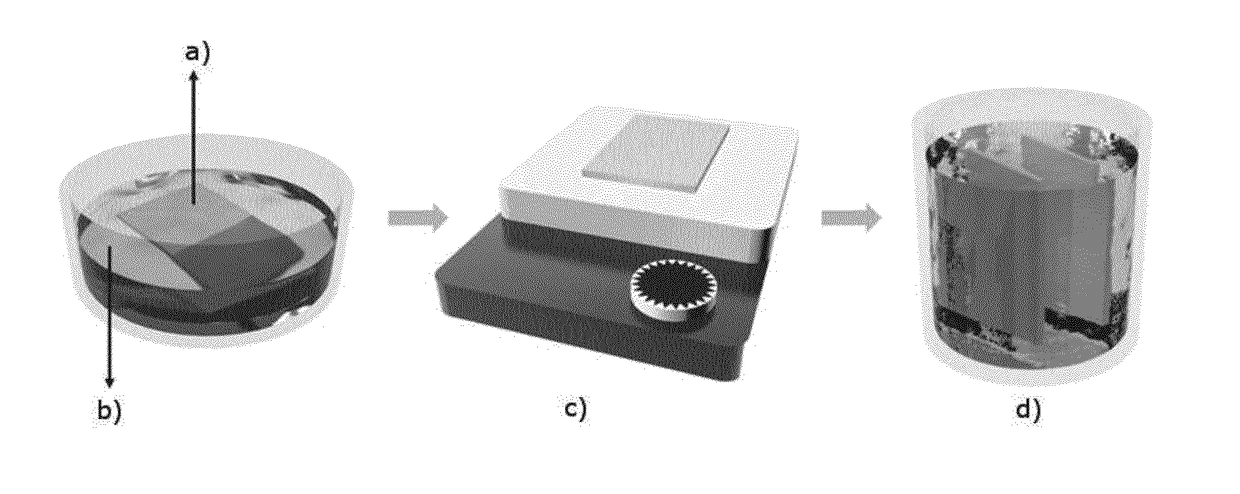Uv-stable and superhydrophobic wood surface
a wood surface, superhydrophobic technology, applied in the field of wood material treatment, can solve the problems of affecting the reliability of wood in various applications, prone to degradation under uv exposure, and degrading the surface, and achieves stable hydrophobic molecules, and low water drop adhesion.
- Summary
- Abstract
- Description
- Claims
- Application Information
AI Technical Summary
Benefits of technology
Problems solved by technology
Method used
Image
Examples
example 1
[0188]The process of wood treatment with ZnO in basic solvent according to the invention comprises the following steps:
[0189]I. ZnO Coating[0190]1) Preparation of basic solution of zinc oxide containing 50 mM ZnO and 5M NH3 by magnetic stirring assisted solubilisation (dissolving solid zinc oxide in aqueous solution of ammonia), the as-prepared solution was denoted as seeding solvent. Ammonium hydroxide (28 wt %; Alfa Aesar) was used to prepare basic solution.[0191]2) Preparation of the growth solution containing NH4NO3 (8.02 g, Sigma Aldrich, p.a. grade), ammonium citrate (0.195 g, Alfa Aesar, p.a. grade) and ZnO powder (8.145 g, Sigma Aldrich, p.a. grade) and 132 ml of NH4OH (28 wt %, Alfa Aesar). The components were loaded into a plastic bottle before pouring 18 MΩ cm deionized water until the total volume reached 2 L. The growth solution was stirred for 12 hours and stored at room temperature until usage. 200 mL growth solution was filtered (1 μm glass fiber filters) into a glas...
example 2
[0211]The process of wood material preparation using Zinc nitrate hexahydrate and hexamethylenetetramine (HMTA) and including a hydrophobization step according to the invention comprises the following steps:
[0212]I. ZnO Coating[0213]1) Preparation of basic solution of zinc oxide containing 50 mM ZnO and 5M NH3 by magnetic stirring assisted solubilisation (dissolving solid zinc oxide in aqueous solution of ammonia), the as-prepared solution was denoted as seeding solvent. Ammonium hydroxide (28 wt %; Alfa Aesar) was used to prepare basic solution.[0214]2) Preparation of the growth solution containing 80 g Zn(NO3).6H2O and 35 g hexamethylenetetramine (HMTA) were loaded into a stainless steel container before pouring deionized water until the total volume reach 6 L.[0215]3) Spruce wood slices (radial (R)×tangential (T)×longitudinal (L) dimensions: 15×1.5×65 cm) were cut and stored in the artificial climate room with a temperature of 20° C. and a relative humidity of 65%.[0216]4) Dippin...
example 3
[0222]The process of wood material preparation with ZnO including the addition of a SiO2 blocking layer and a hydrophobization step according to the invention comprises the following procedures:
[0223]III. ZnO Coating[0224]1) Preparation of basic solution of zinc oxide containing 50 mM ZnO and 5M NH3 by magnetic stirring assisted solubilisation (dissolving solid zinc oxide in aqueous solution of ammonia), the as-prepared solution was denoted as seeding solvent. Ammonium hydroxide (28 wt %; Alfa Aesar) was used to prepare basic solution.[0225]2) Preparation of the growth solution containing NH4NO3 (8.02 g, Sigma Aldrich, p.a. grade), ammonium citrate (0.195 g, Alfa Aesar, p.a. grade) and ZnO powder (8.145 g, Sigma Aldrich, p.a. grade) and 132 ml of NH4OH (28 wt %, Alfa Aesar). The components were loaded into a plastic bottle before pouring 18 MΩ cm deionized water until the total volume reached 2 L. The growth solution was stirred for 12 hours and stored at room temperature until usag...
PUM
| Property | Measurement | Unit |
|---|---|---|
| temperature | aaaaa | aaaaa |
| temperature | aaaaa | aaaaa |
| temperature | aaaaa | aaaaa |
Abstract
Description
Claims
Application Information
 Login to View More
Login to View More - R&D
- Intellectual Property
- Life Sciences
- Materials
- Tech Scout
- Unparalleled Data Quality
- Higher Quality Content
- 60% Fewer Hallucinations
Browse by: Latest US Patents, China's latest patents, Technical Efficacy Thesaurus, Application Domain, Technology Topic, Popular Technical Reports.
© 2025 PatSnap. All rights reserved.Legal|Privacy policy|Modern Slavery Act Transparency Statement|Sitemap|About US| Contact US: help@patsnap.com



